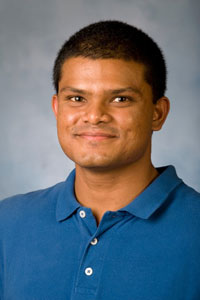CPP Physics graduate Viranga Perera works on project to prepare to land on an asteroid

Landing on an asteroid is notoriously difficult. Asteroids have very little gravity because they have very little mass. Most of them appear to be rubble piles held together loosely, with surfaces covered in boulders and gravels and fine materials, much like the moon, but with a lot more cohesion. On an asteroid, a rock the size of a bank building weighs as much as a cricket on Earth, making an astronaut like a superman. But what would you anchor to, what you would land on and how would you move around?
Because scientists and engineers don’t know the most basic mechanical properties of an asteroid, sending a billion dollar landing mission to an asteroid is risky, and even likely to fail, until some preliminary investigations are conducted, requiring years of lead time.
A team at Arizona State University is looking to mitigate that risk and improve that schedule by building its own "patch of asteroid" inside of a small, spinning satellite costing less than $100,000. The project is called the Asteroid Origins Satellite, or AOSAT I. The team includes CPP Physics graduate, Viranga Perera, now a PhD student at ASU.
Landing on asteroids is one of the biggest challenges of our time,” roboticist Jekan Thanga said. Thanga, an assistant professor in the School of Earth and Space Exploration at ASU, is the engineering principal investigator for AOSAT I. “And space agencies worldwide, including NASA, are very focused on meeting that challenge.”
Erik Asphaug, a planetary scientist and professor at ASU, is the science principal investigator for AOSAT I. He and Thanga plan on launching a miniature satellite later this year that will serve as the world’s first CubeSat microgravity laboratory. A CubeSat is a modular small satellite with a 10-by-10 centimeter base and various unit lengths. AOSAT I will be a 3U configuration, about the size of a loaf of bread, with two spun-up laboratories in the outer units, each housing a patch of real asteroid surface material.
Perera, who is managing the project systems engineering, thinks it is “fascinating that this very low-cost AOSAT platform can be used to study such a fundamental concept as planetary accretion, and that it can serve as a test bed for future asteroid sample return missions.”
Read more at ASU website...
